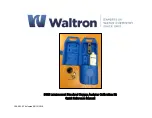
Operation
Biometra TOne
38
}
Use the filed
Go To:
to enter the step to which the program shall return in the loop.
}
Use the field
Cycles:
to enter the number of cyclical reiterations.
}
Confirm the entries by tapping the green check mark.
}
Save the program after completing the changes.
ü
You have programmed a program with a program loop.
Loops
Step
Block Temp. (°C)
Hold Time
(h:mm:ss)
Go To
Cycles
∆T(°C)
∆t(s)
∆R(°C/s)
34x
1
2
3
4
5
6
4.0
2
34
95.0
95.0
55.0
72.0
72.0
16.0
0:05:00
0:05:00
0:00:30
0:00:30
0:00:30
∞
4.0
4.0
4.0
4.0
4.0
Fig. 16
Program with loop (spreadsheet view)
The example shows a loop in which the device first executes steps 1 to 4 and then reit-
erates denaturation, annealing and extension in step 2 to step 4 33 times. In step 5 the
device executes the final extension at 72 °C. In the last step the device cools down the
samples to 16 °C for an indefinite period of time.
Step
Cycles 34x
1
2
3
4
5
6
95.0
95.0
55.0
72.0
72.0
16.0
0:05:00
0:05:00
0:00:30
0:00:30
0:00:30
∞
Step
Step
Step
Step
Step
Temperature [°C]
0
100
20
40
60
80
Fig. 17
Program with loop (graphical view)
In the graphical view, the program loop is illustrated by an arrow. The arrow begins at
step 4, the end of the loop. The arrow points at the step to which the program reiterates
within the loop (here: step 2). The number of cyclical reiterations is indicated above the
arrow.
5.6.7
Programming a temperature increment
Certain applications such as a touch down PCR use temperature increments. The block
temperature is increased or decreased by the set value in each cycle.
ð
Prerequisite: You have opened an existing program or a program template for edit-
ing.
















































